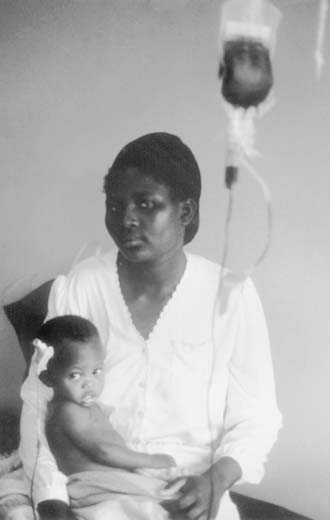Home > About Fogarty > Director's Page > Budget Testimony Archive > FY2001 Statement of the Director
FY 2001 Statement of the Director
Fiscal Year 2001
Statement by
Gerald T. Keusch, M.D.
Director,
John E. Fogarty International Center for Advanced Study in the Health Sciences
Appearing before the House and Senate Appropriations Committees on the FY 2001 Budget.
Mr. Chairman and Members of the Committee, I am pleased to present the President's non-AIDS budget request for the Fogarty International Center (FIC) for FY 2001, a sum of $32,532,000, which reflects an increase of $3,620,000 over the comparable Fiscal Year 2000 appropriation. Including the estimated allocation for AIDS, the total support requested for the FIC is $48,011,000, which is an increase of $4,683,000 over the FY 2000 appropriation. Funds for the FIC efforts in AIDS research are included within the Office of AIDS Research budget allowance.
I am delighted to relate our progress over the past year and our proposed plans for FY 2001. The FIC has taken a lead role in formulating and implementing biomedical research and policy. The programs of the FIC, developed in close consultation with this Committee, reflect our Nation's enduring commitment to global health equity. But disparities in health still exist. While one-fifth of the world's population enjoys an average life expectancy approaching 80 and a life comparatively free of disability, two-thirds of the world's population, living in the least well-off countries of Africa, Asia, and Latin America, suffer overwhelmingly from the world's burden of illness and premature death. According to statistics compiled by the World Health Organization (WHO), each year in the developing world 15 million children die from infection and malnutrition-40,000 children per day-and the toll in sickness and life-long disability has even greater social, economic, and political consequences. [Figure 1] Arguably, reversing this deepening disparity is a public health urgency in the new decade that demands increasingly creative actions from the scientific community.
Disparities in health are not limited by national boundaries. Research on conditions related to poverty in resource-poor nations have universal applications. Most recently, this has been demonstrated by the development of short-course treatment regimens for tuberculosis, field tested initially in Tanzania and now applied by public health authorities throughout the United States. Adapting research advances in biomedicine to populations at home and abroad requires a continuing commitment to basic science as well as rigorous clinical and applied studies. Our mandate at FIC is to serve as NIH's international catalyst by enabling U.S. institutions to extend the geographic scope of research and training. FIC supports over one hundred U.S. institutions that collaborate with more than ninety nations. These efforts are multidisciplinary, embracing clinical, epidemiological, basic biomedical and behavioral research. They are multisectoral, coordinated with our sister institutes at NIH and with international organizations with health and development mandates, including the World Health Organization and World Bank.
One principal strategy of the FIC is to create the human capital and institutional capabilities in developing nations necessary for a productive research enterprise. FIC places priority in four foundation disciplines: First, information science and technology, as both an analytical tool and a means to create global laboratories without walls; second, epidemiological and clinical methodologies necessary to characterize disease burdens and devise and evaluate therapeutic or preventive interventions; third, human genetics and genomics, so that developing nations may contribute to and benefit from international efforts to apply genetic discoveries to clinical practice and therapeutics; and fourth, ethical principles and practice in patient-oriented research, with the intent of ensuring the depth and transparency of the process of ethical review and the involvement of co-investigators and study volunteers as equals in accordance with international guidelines as well as local norms.
The selected examples that follow characterize several of our leading priorities in global health research and training.
Developing Cost-Effective Methods of Preventing HIV
Over ninety percent of the world's estimated 33 million persons infected with HIV live in developing countries (UNAIDS). Within the next five years, 61 of every 1,000 children born in southern Africa will not reach their first birthday due to AIDS and increasing longevity gains will be reversed. Progress in preventing future infections is dependent on rigorous scientific links with developing nations. This is the objective of FIC's AIDS International Training and Research Program, the most extensive HIV research and training network among U.S. schools of medicine and public health and counterparts in developing nations. In partnership with the National Institute of Allergy and Infectious Diseases, FIC provided training and infrastructural support for Ugandan-based trials to prevent perinatal HIV transmission through regimens of the anti-retroviral drug nevirapine. A single oral dose given to an HIV-infected women in labor and another given to her infant within three days of birth reduced the transmission rate by half at a cost of $4.00 per mother-infant pair. If implemented widely in developing nations, this intervention could prevent some 400,000 newborns per year from beginning life infected with HIV.
Novel Approaches to Treatment and Control of Emerging Infectious Diseases
Coupled with the AIDS crisis, parasitic and other infections continue to compound the burdens of mortality and chronic illness as well as impede economic growth in affected regions. According to WHO, malaria kills close to 2 million people each year, most are children under the age of five, and an estimated ½ to 1 billion cases of malaria occur [Figure 2], and this is closely associated with poor economic performance in the affected countries. Progress will require a new public health paradigm: An integrated approach to prevention and control, incorporating improvements in case management, rational drug use to limit the spread of resistance, monitoring and evaluation of control measures, and development of new diagnostic tools, drugs and vaccines. Moreover, the spread of HIV is hastened through the use of unscreened blood to treat the life-threatening anemia that often develops in malaria-infected individuals. This reinforces the need for operational strategies to ensure the safety of the blood supply and transfusion practices for the anemia of malaria, a major complication of the infection [Figure 3]. The Multilateral Initiative on Malaria (MIM), an alliance of scientific and development agencies and African partners, was launched with major support from FIC and NIAID to address these critical needs. FIC now serves as the worldwide focal point for the MIM. To promote the agenda to reduce the burden of malaria, FIC has initiated a new research and training program to link U.S. and, in particularly, African institutions. The MIM constitutes a maturing model-a paradigm of cross-sectoral cooperation that FIC hopes to adapt to other global health urgencies.
The field of malaria and other tropical infections has reached a watershed, demonstrating the potential for application of tools of molecular and cell biology to render formerly intractable problems approachable. For example, dengue fever and its most severe form, dengue hemorrhagic fever/dengue shock syndrome, are considered among the most important and widespread reemerging infectious diseases in the developing world, including the Caribbean. Global warming impacts on mosquito vectors that makes this a threat to the U.S. mainland as well. To date, existing methods to diagnose and characterize dengue viruses have been costly and complicated to perform, particularly in developing countries with limited capabilities and resources. Under FIC support, the University of California at Berkeley and the Ministry of Health in Nicaragua have developed a new technique to rapidly, accurately, and inexpensively define the virus responsible for dengue in Central America. This method is known as restriction site-specific PCR (polymerase chain reaction). Using this new information, local health authorities now are able to track the movement of the dengue virus from Asia and Africa to the Americas, which is the start of control efforts.
Dengue is among more than thirty-five infectious diseases that have emerged or reemerged around the world in the past twenty-five years. Most recently, the outbreak of encephalitis in the New York region was attributed to the West Nile Virus, its first known introduction into the Western hemisphere. Although it is not clear how the virus migrated to the United States, this outbreak is representative of the continual challenge that newly emerging microbes present for U.S. citizens. Emerging infectious diseases are infections that are new in the population, rapidly increasing in incidence or expanding in geographic range. Most are caused by "microbial traffic"-that is, the introduction and dissemination of existing agents into human populations either from other species or from smaller populations, often precipitated by rapid ecological and environmental change. To better comprehend the consequences of changes in terrestrial and marine ecosystems on human health, the FIC, in partnership with several NIH Institutes, the National Science Foundation, and other U.S. agencies, initiated an interdisciplinary research program to elucidate the underlying biology of habitat and biodiversity changes that may lead to increased disease prevalence in humans and, thus, fill an important gap in our understanding of these interrelated dynamics. With this information, we will be able to develop data and predictive models to anticipate future outbreaks and devise corrective actions before the disease strikes.
Taking Steps to Address Emerging Epidemics of Noncommunicable Disease: FY 2001 Initiatives
The classic burdens of infectious diseases in developing nations are now joined by a new class of epidemics. According to the Global Burden of Disease Study commissioned by the World Bank, over the next twenty-five years as populations age and risk exposures shift, non-communicable diseases will become the leading source of disability and premature death in developing nations. Both the pace of these changes and the sheer numbers affected will exceed the Western experience. By working in partnership with scientists in low- and middle-income nations, risk factors may be evaluated and interventions developed that will be of benefit to both industrialized and developing nations. The emerging epidemics of chronic disease in developing nations constitute FIC's major programmatic thrust for FY 2001.
In cooperation with the WHO Tobacco Free Initiative and multiple NIH partners, FIC will establish a research and training program to improve international efforts to control the tobacco epidemic. Among other objectives, the program will address large gaps in our knowledge relating to the burden of death and disability associated with tobacco use in developing nations, such as behavioral determinants of smoking uptake in youth. The Center also will launch a similar effort directed at prevention and management of mental health disorders-an unseen epidemic in most developing countries. At any give time, an estimated 10 percent of the population in developing nations suffers from severe anxiety, depressive disorders and other psychosocial problems (World Mental Health: Problems and Priorities in Low-Income Nations, Oxford University press, 1995). Through international partnerships, we hope to begin to rectify the shortfall of well-trained clinical investigators and epidemiologists in mental health fields in developing nations. Moreover, we will begin to generate epidemiological data on the incidence of mental health disorders and risk factors, including sociocultural determinants of mental health in societies undergoing transition to industrialized economies.
In FY 2001, the FIC also proposes to create new linkages with developing nations in the field of molecular medicine, emphasizing research and training related to the complex interplay between genes and the environment. The genetic maps, physical maps and technologies that have emerged from the human genome sequencing effort have enabled the research community to accelerate dramatically the discovery of genes underlying disease or risk factors for disease. We are now positioned to advance understanding of population genetics and dynamics for chronic conditions that affect industrial and developing nations alike, such as hypertension, type 2 diabetes, asthma, and breast cancer. FIC's long-range goals are to define some of the genes involved in multigenic disorders of global priority and then test the predictive strength of these particular polymorphisms in prospective, community-based studies. Ultimately, diagnostic, therapeutic, and prevention strategies will evolve.
Our current efforts in this field already have yielded promising leads. Scientists at the University of Washington have teamed with scientists from Tel Aviv University in Israel and Bethlehem University in the Palestinian Authority to map and clone the genes responsible for different types of inherited deafness-both progressive and early-onset. The incidence of preverbal deafness is an estimated five to ten percent in this region, among the highest in the world. Loss of hearing may be due to environmental factors or to genetic mutations in any one of a large number of genes. These genes encode proteins crucial for the proper development, structure and function of the inner ear. There may be more than 100 such genes, however only a fraction have been identified. Identifying these genes and defining the mutations that cause deafness through these novel studies will lead to a better understanding of the biology of hearing.
Conclusion
These programs and initiatives are representative of a broad spectrum of international research and training efforts supported by FIC. The programs of FIC recognize a deeper philosophic purpose and vision. Advances in biology over the past decades have demonstrated social and global interdependence. This is a condition of health for the biosphere as much as it is an imperative of societal well-being. There is a deepening consensus that individuals and nations share an inherited and acquired sense of social altruism-an understanding of common fate and a shared set of social obligations. The pursuit of health through international scientific cooperation is an inherently global enterprise and one that ultimately improves the public health of this Nation as well.
The NIH budget request includes performance information required by the Government Performance and Results Act (GPRA) of 1993. Prominent in the performance data is NIH's first performance report, which compares our FY 1999 results to the goals in our FY 1999 performance plan. As our performance measures mature and performance trends emerge, the GPRA data will serve as indicators to support the identification of strategies and objectives to continuously improve programs across the NIH and the Department.
Thank you, Mr. Chairman. I will be pleased to answer any questions.
Figure 1

Malnutrition and infectious diseases are deadly allies. In this photo, a young Bangladeshi child is shown with acute severe malnutrition which has been precipitated by a bout of bacterial dysentery. Without expert care this child is likely to die during the next week or two. Even if he survives the episode, his chances of dying in the next 6 months are several times greater than an unaffected child. And even if he survives that, the impact of this stress, so early in life, is likely to be felt during his childhood, limiting his growth, development, and learning capacity and, ultimately, his economic productivity.
Figure 2

This photo is of a young African boy with severe malaria affecting the brain. This condition, called cerebral malaria, is one of the most dreaded complications of severe malaria. Treatment requires not only drugs to tackle the malaria infection but also skilled management to deal with the emergency problems due to brain swelling caused by the infection. Even if this patient survives, there is a strong likelihood that he will be brain damaged for the rest of his life. This is a serious consequence for family, community, and nation.
Figure 3

Blood transfusion in the United States is a highly organized, safe and life-saving procedure, but this is not true in most low income countries. In this instance, a child is being transfused through a vein on his head to treat severe anemia caused by malaria. Blood transfusions are more commonly unsafe than safe in this setting, as there is often no means or capacity to ensure that blood used for transfusion is safe or that transfusion equipment is sterile.

